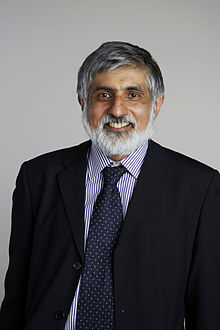Philip Maini
Philip Kumar Maini (born October 16, 1959 in Magherafelt ) is a British mathematician who studies mathematical biology.
Life
Maini studied mathematics from 1979 onwards at Oxford University with a bachelor's degree in 1982, a master's degree in 1986 and a doctorate in 1985 with James D. Murray . From 1984 he was College Lecturer at Corpus Christi College and 1987/88 at Balliol College in Oxford (in between he was Assistant Master in Eton in 1986). In 1987/88 he was a Junior Research Fellow at Wolfson College , Oxford and in 1987 Assistant Professor at the University of Utah . In 1990 he became University Lecturer in Mathematical Biology at Oxford (and tutor at Brasenose College ) and in 1998 Professor and Director of the Center for Mathematical Biology. In 2005 he became a professorial fellow at St John's College , Oxford.
From 2006 to 2009 he was also a professor at the Queensland Institute of Technology in Brisbane . He was also visiting scholar at the University of Bonn, the University of Utah, the Humboldt University in Berlin, the Max Planck Institute for Mathematics in Leipzig, the University of Paris-Süd, the University of Tokyo, the National Autonomous University in Mexico City , the University of Leiden, the University of Florence, the Bulgarian Academy of Sciences, in Recife, the Kavli Institute for Theoretical Physics in Santa Barbara and the University of Washington.
plant
He dealt with modeling, for example, in cancer biology (e.g. a multi-scale model for vascular tumors), chemotaxis of bacteria, normal and abnormal wound healing, developmental biology (bone formation in vertebrates, calcium signal system in embryogenesis, investigation of models of morphogenesis with mechanical effects, pattern formation) , Pattern formation in slime molds ( Dictyostelium ), collective movement of insects, dynamics of rainforests, immunology and epidemiology. He showed, among other things, that heterogeneity in tumor models can have a major impact on their development over time and that various cell cycle regulatory mechanisms of the p27 protein give tumor cells advantages over normal cells in an oxygen-poor environment (which supports the thesis that the different behavior of normal and tumor cells if there is a lack of oxygen due to this protein). In developmental biology, he used mathematical models to investigate how various bone abnormalities can arise in the embryo development of mice and how certain transforming growth factor -beta reduce scarring during wound healing .
The methods used range from stability theory and bifurcation analysis of systems of differential equations (ordinary and partial), investigation of asymptotes and on multiple scales in time and space to numerical simulation with agents and lattice gases.
Honors and memberships
In 2002 he became a Life Fellow of Clare College. In 2001/02 he was a Senior Research Fellow of the Leverhulme Trust of the Royal Society.
In 2009 he received the Naylor Prize and in 2006 the Wolfson Prize of the Royal Society. He is a SIAM Fellow and a member of the Academia Mexicana. In 2015 he was elected to the Royal Society .
Web links
Individual evidence
- ^ Mathematics Genealogy Project
- ^ According to the model proposed by Oster, Murray, Harris 1983 as an alternative to chemical morphogenesis according to Alan Turing . George Oster , James D. Murray, A. Harris Mechanical aspects of mesenchymal morphogenesis , J. Embryol. Exp. Morphol. 78, 1983, 83-125
- ↑ When there is a lack of oxygen, it is activated more intensely and suppresses DNA synthesis. See also tumor suppressors .
- ↑ The multiple scales make the mathematical treatment of many problems in biology difficult
| personal data | |
|---|---|
| SURNAME | Maini, Philip |
| ALTERNATIVE NAMES | Maini, Philip Kumar |
| BRIEF DESCRIPTION | British mathematician |
| DATE OF BIRTH | October 16, 1959 |
| PLACE OF BIRTH | Magherafelt |
